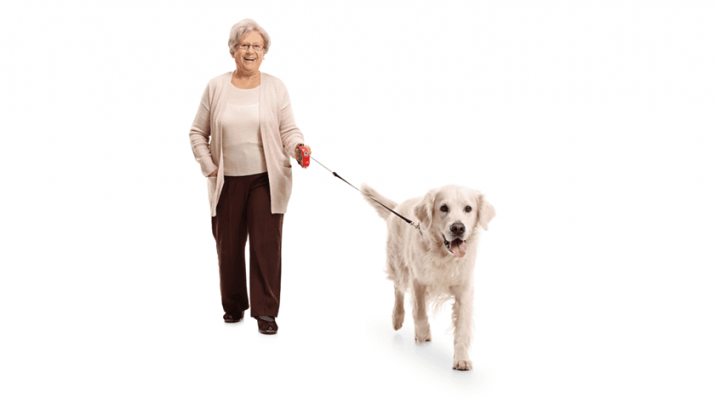Fall-related bone breaks involving senior dog walkers has risen substantially. But there are ways for seniors mitigate the problem
By Deborah Jeanne Sergeant
Owning a dog can provide lots of motivation to get out and walk. While that’s great for your health, dog walking can raise the risk of falling, especially if you’re an older adult.
A study recently published in JAMA Surgery looked at 100 hospital emergency rooms nationwide. The number of fall-related bone breaks involving senior dog walkers has risen substantially for more than a decade, from 1,671 in 2004 to 4,396 in 2017.
Of those involved with the study, 79% were women, who because of their smaller bone structure are more at risk for bone breaks. The most commonly broken bone was the hip (17%) but more than 50% broke an upper body bone, including the shoulders, arms, hands, wrists and fingers. Nearly one-third required hospital admission. The researchers blame both dog manners and owner conditioning.
Many elderly people who experience a hip fracture never quite regain the level of health they experienced previously. Some also become so deconditioned that they can no longer live independently.
Physician Raul Vazquez, with Greater Buffalo United Accountable Healthcare Network (GBUAHN), recommends that older adults receive a full screening for fall prevention.
“Based on the screening, you could have macular degeneration and you don’t realize you have a blind spot,” Vazquez said. “You may not know you have hearing issues, which can effect balance, or foot problems, like bunions.”
Deterioration in physical fitness may also contribute to dog-walking related falls, since muscle mass and balance tend to decline with age. For that reason, Warren Paschetto, certified personal trainer and certified strength and conditioning specialist, recommends increasing strength to improve stability, which can help prevent a fall.
“Balance is huge and something I work with a lot no matter what the age,” Paschetto said.
He owns Warren Paschetto Fitness in Williamsville.
“I’m in my mid-40s,” he added, “and I’ve lost some balance. In the studio, we try TRX bands and balancing on one foot.”
Walking lunges also help improve strength and balance. For an older individual at home, he advises practicing lunges or standing on one foot with stable furniture nearby.
“Practicing these will definitely help with walking the dog,” Paschetto said.
Using the right equipment will make a big difference while walking the dog. Wearing stable footwear as well as selecting the right leash can greatly improve safety.
Kim Sauer, certified professional dog trainer, dog walking academy graduate, and owner of Sit ‘N Stay Pet Services in Orchard Park, suggests harnesses that fit at the front of the chest instead of the back, or a head harness.
“They are very effective at controlling dogs,” Sauer said.
Owners should also hold their leashes properly. Wrapping it around the hand means that if the dog pulls, they’re likely going down.
“It’s much better to let go, even though people don’t want to, than to be dragged down by the dog,” Sauer said. “Equally as important is basic training of the dog to make sure the dog has good impulse control. They have good leash walking skills and learn to walk on one side, instead of going back and forth.”
If you’re in the market for a new dog, consider your choice carefully. Large, powerful dogs may be much harder to control than a smaller dog. But the dog’s personality and age also make a difference.
“With a puppy, it’s a guesstimate of what you’re going to get,” Sauer said. “If you’re looking at an older dog, you know the energy level so that can be a great benefit.”
The dog’s breed can influence these tendencies and the need for exercise. Working dogs, like German shepherds for example, need much more exercise than dogs bred as companion dogs, like King Charles spaniel. The dog’s exercise needs should match your lifestyle, fitness level and desire to walk.

